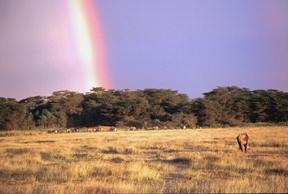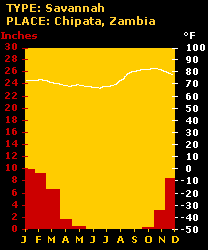|
Tropical Savannah
The tropical savanna is a biome characterized by tall grasses and
occasional trees. Large regions of tropical savanna extend through
the nations of Botswana, Namibia, and Kenya in Africa, southern
Brazil, India, and Australia. Surprisingly, the Everglades of southern
Florida in North America is also a tropical savanna. Photo
© 2000-www.arttoday.com

Savannas exist in areas
where there is a 6 to 8 month wet summer season and a dry winter
season. Annual rainfall in savannas varies depending on the geographic
location. Some savannas get as little as 10 inches of rain annually
while others can get as much as 50 inches. The dry season is marked
by months of drought and fire which are essential to the maintenance
of savannas. Without the period of drought and fire, some scientists
believe that tropical savannas would eventually change into tropical
forests.
Savannas can result
from either climate, soil conditions, animal behavior, or agricultural
practices, which limit the occurrence of trees. Humans create savannas
by burning the grasslands and felling the trees in order to plant
crops. Large animals such as elephants can turn a forest into a
savanna by stripping the bark from the trees, knocking over trees,
and tramping on tree seedlings.

Back
| Next
|











